
Getting Started
Highlander the Card Game
2E
This page will cover a lot of what you need to know to get started with Highlander the Card Game 2E
The Concept of the Game
Highlander the Card Game simulates a battle or duel between two characters or Immortals from the Highlander franchise. The SwordmasterTM game system makes attacking a defending fun and easy to understand. Attacks and Defenses use the SwordMaster grid system to show you where an attack is aimed and where a defense defends.
The goal of the game is to reduce your opponent’s Ability to zero or to take their Head with a Head Shot before your opponent does the same to you. If either player plays a successful Head Shot, they immediately win the game regardless of who has the higher Ability.
During the course of a game, players will Attack, Defend, and play Special Cards that can control other aspects of the game.
What you'll need to play
Making a Highlander Deck - The Basics
A Highlander deck is made up of two types of cards that are chosen by you when designing and building your deck.
Your Pregame Cards + your In Game Cards = Your Deck
1.) Pregame Cards (Collectively referred to as your “Pregame”) These cards do not have the standard card back. They do not count toward the total number of cards in your Endurance. Pre-Game cards can’t be placed into a player’s Hand, Endurance or Discard Pile. You cannot use more than one copy of any Pregame card.
2.) In Game cards (This is known as your “Endurance”) - These cards all have the standard card back. These are the cards you will play from your Hand (attacks, defenses, special cards, and edge cards). During the course of the game you will draw cards from your Endurance to replace the cards you play from your Hand. There a few different types of In Game Cards:
•Generic Cards - any Immortal can use these
•Persona Specific/Faction Specific Cards - To use these you must include a matching Pregame card of that Immortal or Faction.
•Weapon of Choice
Each player needs a constructed Deck of a minimum of at least 50 In Game Cards and at lest 1 Persona Pregame card.
You may have up to 6 total Pregame Cards if you so choose. You may find it useful, for example, to add extra Pregame cards beyond your Persona Pregame to make your deck more potent or give you more options when constructing your Deck.
Of the 50 In Game Cards, each Deck is required to have 6 Basic Blocks and 9 Basic Attacks. Outside of those 15 cards, the remaining In Game cards you use is up to you.
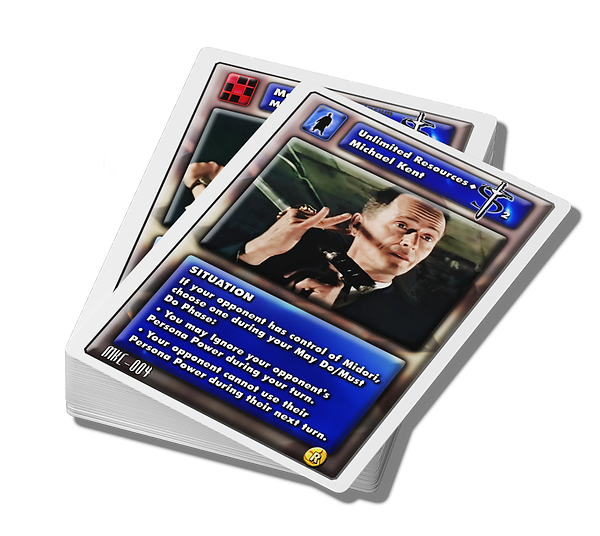
Pregame Cards
Persona Pregame Cards
Your Persona Pregame card represents the Immortal from Highlander that you are playing as during the duel. This card is referred to as your "Persona".
Each Persona Pregame card has a unique Power and mix of Attribute Gems. An Immortal’s Attribute Gem scores as well as their unique power listed on the back of their Persona are based on the character and the skills, traits, and fighting style/prowess he or she displayed in the Highlander franchise
Persona card Back
Older Versions of Persona Cards
When 2E initially came out, the back of Personas looked a little different from the more current releases.
The Attribute Gems were displayed in single digits and you have to multiply them by 3 to get the total gem allotment for that Persona.
*You do not multiply the Master Gem number by three on the older Personas.
Old School Persona Back
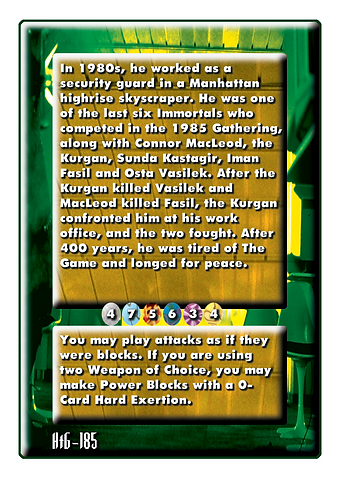
The Attribute System in Highlander the Card Game 2nd Edition (The "Gems")
The scores for each Attributes (Gems) will effect your deck building experience with a given Immortal/Persona.
Each Immortal has a unique blend of Attributes based on their character and skills they posses as an Immortal. As seen in the above example, the Attributes listed on the back of a Persona Pregame card represent the maximum amount of each Attributes an Immortal can include in their Deck/Endurance.
Attribute Gems are allotted to most In Game cards to represent the skills needed to include that card in your deck to perform the action of that card.
The Attribute Gems form the the acronym MASTER and represent the following traits:

MASTER - This score sets the limit of how many Master Cards you are allowed to have in your Deck. A Master Card is a type of In Game card that usually has a powerful upside that simply has the word “Master” included in the title. Older Immortals or ones who have become experts in a specific area of combat (as portrayed in the TV Show, Movies, etc.) will have a higher Master score than younger, less experienced Immortals.

AGILITY - This score sets the limit for how many Agility Gems you may have in your Deck. The Agility score represents how agile and athletic an Immortal is. For example, playing multiple attacks per turn may require the use of cards with the Agility Gem, so using a Persona that can move quickly and has a higher Agility score might make your deck building go more smoothly. Many Immortals who have a high Agility Score may also have better In Game Evades or Counters and maybe even a Master’s Dodge.

STRENGTH - This score defines how strong an Immortal is. An Immortal with a high strength score, for example, may be able to use a Two Handed Weapon with only one hand. Or they may have an easier time making Power Blows. Or maybe, their attacks do more damage to due their strength.

TOUGHNESS - This score represents the mindset of an Immortal and how much punishment they are willing to take. Some Immortals revel in the Game and fighting other Immortals in their quest to the the "One".

EMPATHY - This score depicts how well your Persona relates to other people and whether they are generally a good Immortal or bad Immortal. Immortals with a higher Empathy scores may have Persona Specific Allies that they can use to help them win the battle. These are In Game cards that depict characters from the Highlander franchise that were friends, loved ones, or even mentors. Immortals who were loaners and or evil generally have a lower Empathy score, making it harder for them to build around In Game cards with the Empathy Attribute.

REASON - This is a measure of a Persona’s intelligence. Immortals with a high Reason score will usually have Persona Specific In Game cards that can help the Immortal control other aspects of the game beyond simple attacks and defenses.
Generic Pregame Cards
In Highlander the Card Game, players can use "Generic" Pregame cards meaning that any Immortal can use them in their Pregame. These include pregame cards like Weapon of Choice, Quickenings, Arms and Tactics, and Crystals to name just a few. You can use these types of Pregame cards to bolster your deck strategy or to extend the abilities of an Immortal you enjoy playing as.
Hover over each image to read the back of the card.



Quickenings are a unique Pregame card in Highlander the Card Game. A Quickening gives you the added ability of another Immortal. Think of it as having 2 Persona Powers. But use these at your own risk. If your opponent takes your head, you must give them your Quickening card at the end of the game.



Every Immortal in Highlander the card game begins the game with a default, basic sword to fight their duel. Players can choose to use a dedicated Weapon Choice in their Pregame. WOC cards give you an extra power, but they do have a downside. Each WOC does have its own In Game cards you can use if you are using the associated Pregame card.
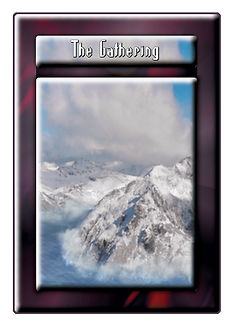
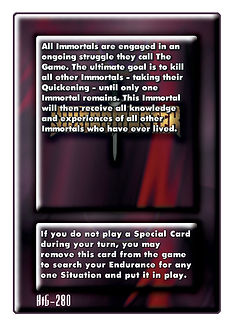

The Gathering Pregames allow you to search for a specific card in your Endurance and put that card into play. These can be really helpful if your Immortal needs to use Special cards to reach their full potential.
1.) In Game Cards
Lets get familiar with the anatomy of an In Game card for Highlander the Card Game.
In Game Card Designs
Persona Specific In Game Cards
In Game cards in Highlander often have different visual backgrounds and themes. Each Immortal has their own unique design and theme. Here's a few examples of the unique designs of various Persona Specific cards for certain Immortals. You can explore every Persona Specific card for Highlander the card game 2nd Edition HERE.
![[MASTER] Kalas - Master Block.jpg](https://static.wixstatic.com/media/81ef3c_d191834590e340a08e0ca2660c88d76e~mv2.jpg/v1/fill/w_238,h_333,al_c,q_80,usm_0.66_1.00_0.01,enc_avif,quality_auto/%5BMASTER%5D%20Kalas%20-%20Master%20Block.jpg)
![[EVENT] Jacob Kell - Deadly Intent.jpg](https://static.wixstatic.com/media/81ef3c_e77720c9dfbe40df9e16175c3ae630c2~mv2.jpg/v1/fill/w_238,h_333,al_c,q_80,usm_0.66_1.00_0.01,enc_avif,quality_auto/%5BEVENT%5D%20Jacob%20Kell%20-%20Deadly%20Intent.jpg)
![[PLOT] Xavier - For Tmrw We Die.jpg](https://static.wixstatic.com/media/81ef3c_09b6130432d94432ad5f070c1cef7613~mv2.jpg/v1/fill/w_238,h_333,al_c,q_80,usm_0.66_1.00_0.01,enc_avif,quality_auto/%5BPLOT%5D%20Xavier%20-%20For%20Tmrw%20We%20Die.jpg)
Generic In Game Cards
Many of the generic In Game cards in Highlander the card game have unique designs as well.
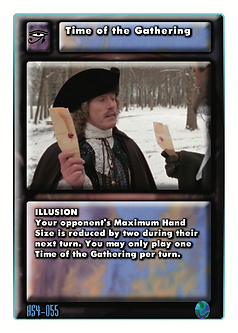

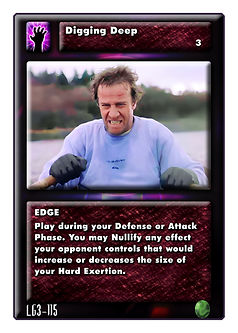
In Game Card Types In Highlander The Card Game
Basic Attack &
Attack Icon
Special Attack Icon
There are different types of attacks in Highlander the Card Game. You use attacks to inflict combat based damage to your opponent. Some attacks can be made into Power Blows which do extra damage. Each immortal generally has at least one unique attack. Many Weapons also have unique attacks.
Basic Attacks: These Red Grid attacks do -2 damage by default and can be made a Power Blow by making an Exertion. In the Card Type/Card Subcategory you will see the text, "BASIC ATTACK". You are required to include the 9 basic attacks (UL,UC,UR,ML,MC,MR,LL,LC,LR) in your deck.
Attacks: Like Basic Attacks, these attacks have a Red Grid. The difference between this type of attack and a basic attack is that non-Basic red gridded attacks usually have an extra effect due to the card text or could be subset of attacks like Dirty Tricks. Dirty Tricks are attacks that are carried out without your main weapon.
Special Attacks: Special Attacks have a gold/yellow grid icon. Special Attacks cannot be made a Power Blow by making a Hard Exertion but can often be Power Blows due to card text. Special Attacks may not be played Hidden, and may not be pulled from an Exertion when searching for an attack. There are a few sub-types of Special Attacks you'll come across, things like Ranged Attacks (an attack using a firearm) or Martial Arts attacks.
![[ATTACK] Methos - Finishing Stab.jpg](https://static.wixstatic.com/media/81ef3c_1fd27557166f4af6bba1f43871e919ae~mv2.jpg/v1/fill/w_250,h_350,al_c,q_80,usm_0.66_1.00_0.01,enc_avif,quality_auto/%20%5BATTACK%5D%20Methos%20-%20Finishing%20Stab.jpg)
![[MASTER] Steven Keane Master's Attack.jpg](https://static.wixstatic.com/media/81ef3c_cee94547057d431f9d2ed2e0ab593657~mv2.jpg/v1/fill/w_250,h_350,al_c,q_80,usm_0.66_1.00_0.01,enc_avif,quality_auto/%5BMASTER%5D%20Steven%20Keane%20Master's%20Attack.jpg)

![[PRE GAME] Steven Keane - Persona Front.jpg](https://static.wixstatic.com/media/81ef3c_87169bb0c42540c4b15a0465c428bbbd~mv2.jpg/v1/fill/w_340,h_477,al_c,q_80,usm_0.66_1.00_0.01,enc_avif,quality_auto/%5BPRE%20GAME%5D%20Steven%20Keane%20-%20Persona%20Front.jpg)
![[PRE GAME] Steven Keane - Persona Back.jpg](https://static.wixstatic.com/media/81ef3c_6bb476eb58ef4663becde9d62aa4a5c8~mv2.jpg/v1/fill/w_340,h_477,al_c,q_80,usm_0.66_1.00_0.01,enc_avif,quality_auto/%5BPRE%20GAME%5D%20Steven%20Keane%20-%20Persona%20Back.jpg)


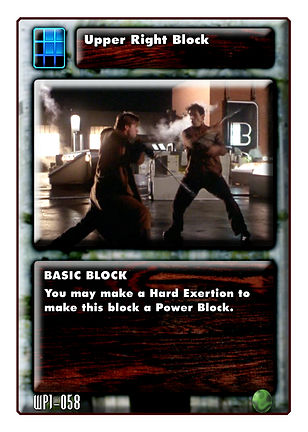
![[EVENT] Connor MacLeod - I Am Connor MacLeod.jpg](https://static.wixstatic.com/media/81ef3c_4c6de18343eb4edfb70c14fb938405b0~mv2.jpg/v1/fill/w_308,h_432,al_c,q_80,usm_0.66_1.00_0.01,enc_avif,quality_auto/%5BEVENT%5D%20Connor%20MacLeod%20-%20I%20Am%20Connor%20MacLeod.jpg)

![[OBJECT] Jacob Kell - Hilt.jpg](https://static.wixstatic.com/media/81ef3c_745cccc93c5f4fa597e6c25bdf902a39~mv2.jpg/v1/fill/w_308,h_432,al_c,q_80,usm_0.66_1.00_0.01,enc_avif,quality_auto/%5BOBJECT%5D%20Jacob%20Kell%20-%20Hilt.jpg)

![[SITUATION] Nick Wolfe Private Detective.jpg](https://static.wixstatic.com/media/81ef3c_c8c0f26f9265447fa098c4c909686f83~mv2.jpg/v1/fill/w_308,h_432,al_c,q_80,usm_0.66_1.00_0.01,enc_avif,quality_auto/%5BSITUATION%5D%20Nick%20Wolfe%20Private%20Detective.jpg)
![[PLOT] Xavier - Necessary Evil Joining Forces.jpg](https://static.wixstatic.com/media/81ef3c_61adee68dc484acb835be1d24dba995e~mv2.jpg/v1/fill/w_308,h_432,al_c,q_80,usm_0.66_1.00_0.01,enc_avif,quality_auto/%5BPLOT%5D%20Xavier%20-%20Necessary%20Evil%20Joining%20Forces.jpg)